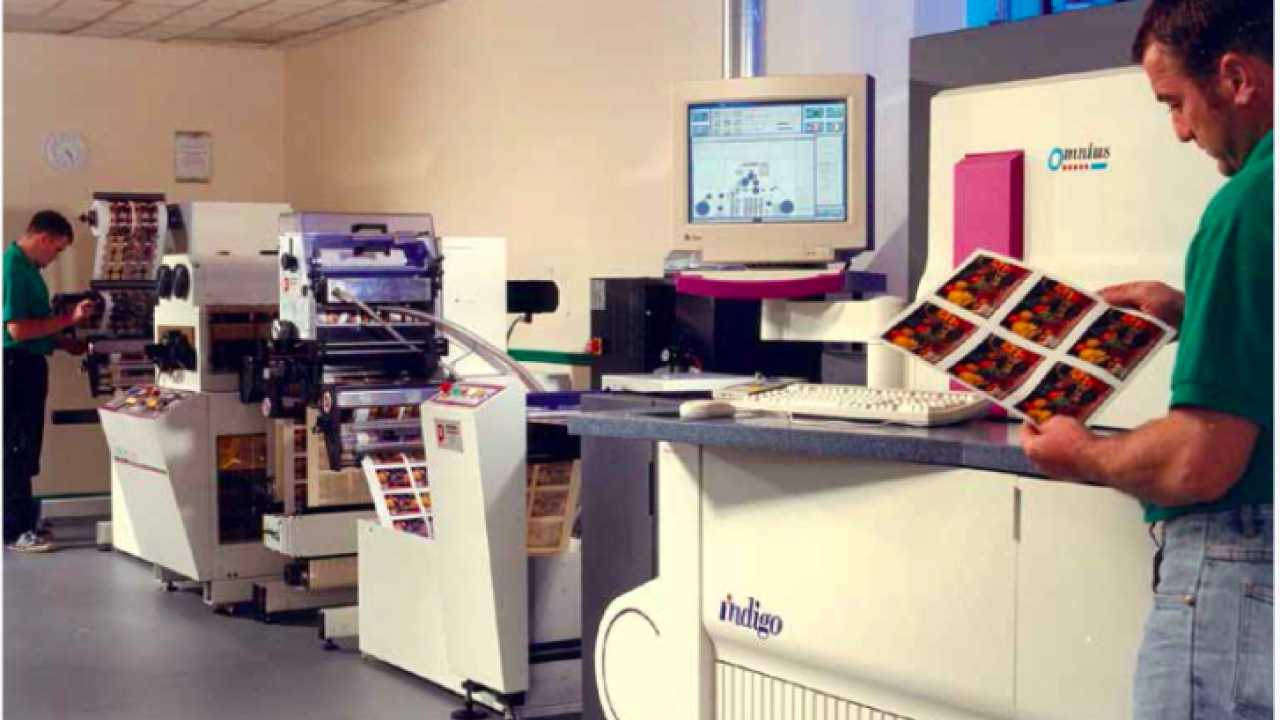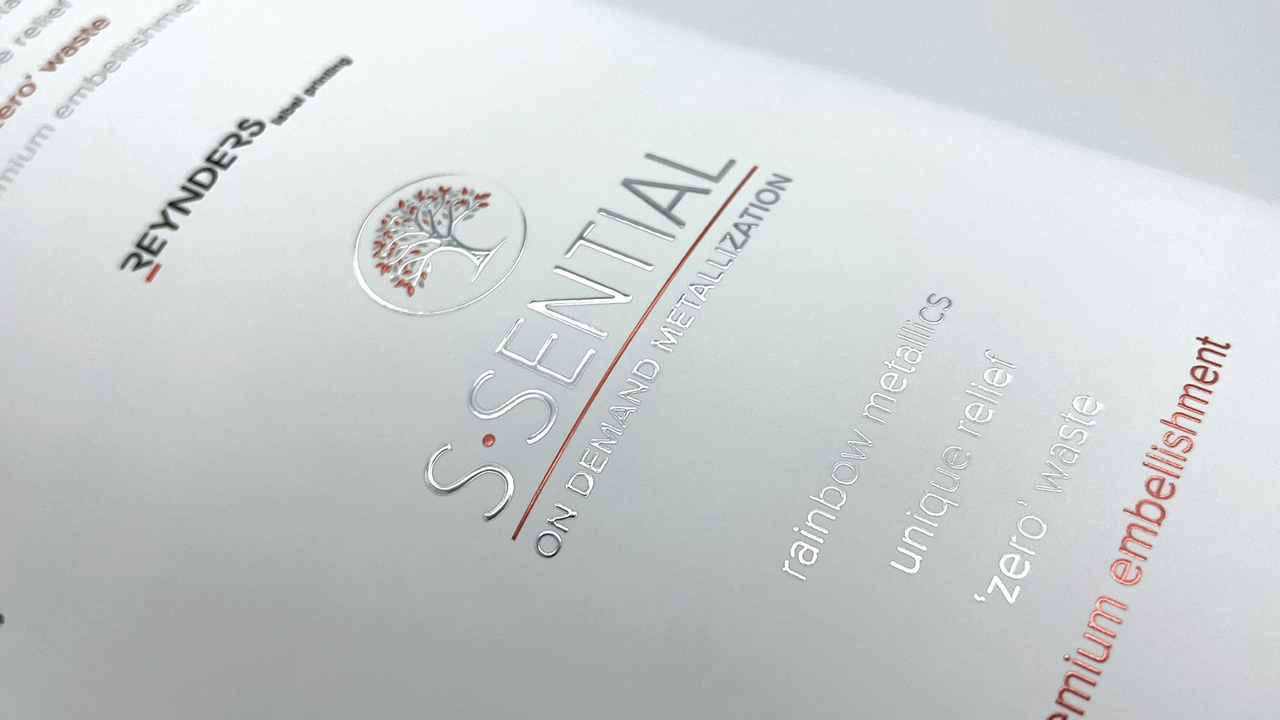Digital disruption

The history of digital printing is almost synonymous with the introduction of the technology into the label industry. The promise of digital printing in a conservative market was a vision that would eventually create an industry.
Step by step, over 23 years, Indigo has not only perfected a digital process for label printing, but also created an entire digital ecosystem. More recently, HP Indigo digital printing is entering into new frontiers, extending the continuous digital process with embellishment.
In 1993, the first digital offset color printing press, the E-Print 1000, was introduced to the world by Indigo at Ipex. The product debut shook the printing industry to its foundations and launched a new era. The innovative Indigo process was quickly transcribed to label printing.
The digital revolution brought a fundamental change by matching conventional printing quality, while at the same time enabling on-demand, short-run color printing and the run length of ‘one’, thereby opening the door to customized labels and the possibility to streamline supply chains.
Today, HP Indigo presses lead the industry with some 75 percent of the digital label market. In some countries, almost 100 percent of labels in certain applications are printed digitally on HP Indigo presses. Strategic campaigns have become the norm as major brands use Indigo digital printing to drive worldwide campaigns.
The Share a Coke campaign, launched in Australia in 2011, spread first to Europe and then worldwide, reaching over 10 billion printed labels. This campaign redefined the marketing of the package in the age of social media, making a historic impact on consumer goods marketing with a race to share in the ‘Share a Coke’ moment.
As Labels & Labeling celebrates 40 years documenting the industry, let’s look back at how Indigo, also established four decades ago, engineered market disruption and eventual commercial success for digital label printing.
Early generation presses
After its splash at Ipex, Indigo made its first drupa appearance in 1995, where it showed not only the E-Print 1000, but also its first concept label press, the Omnius. Announced in January 1995, the introduction of the press helped propel the stock price of the newly publicly traded Indigo as the market understood the potential.
The Omnius could basically print on any media for production of customized labels and cartons. Way ahead of its time, the Omnius sparked the digital label and packaging market with a much smaller footprint – seven times smaller than the industry standard – with better quality printing. In comparison, some offset machines were 50 to 60 meters long and two stories high and needed two to three hours and two operators to set up.
The next label press, the Indigo Webstream 100, was twice as fast as the Omnius. Innovation extended to the IndiChrome 6-color printing project adding orange and violet inks to the CMYK set for an extended brand color matching gamut. Later, green ink was added. The first Webstream press was demonstrated at Labelexpo Americas 2001. The first Beta customers were Tap in the US, Adesa in France and Rako in Germany – today part of the All4Labels Group and a leading HP Indigo digital printing label house. The Webstream would lead to the Indigo ws4000 series dynasty.
HP’s acquisition of Indigo in 2001 was the watershed in Indigo digital printing. The US$830 million deal gave the capital infusion that helped scale the business.
At Ipex 2002, Indigo introduced a new generation label press which started the era of the ws4000 series, also known as Series 2. Once again, printing speed doubled compared to the previous model. Seven-color printing was another advancement, opening new possibilities.
The Indigo ws4000 was followed by the ws4050, ws4500 (drupa 2004) and ws4600. More than 800 units of the Indigo ws4000 series printed over 23 billion impressions for customers worldwide by the time the last unit was manufactured in April 2015. That unit, a ws4600, was sent to a customer in China.
The Series 2 press was retired in 2015, replaced by growing demand for the WS6000 Series which delivered higher capacity and high-performance features.
At drupa 2008, the unveiling of the HP Indigo WS6000, the new-generation Series 3, offered the highest digital productivity for a range of applications, doubling the throughput of the HP Indigo ws4000 series. This marked the launch of the game-changing WS6000 series. Global brands, including Nestlé, P&G and Coca-Cola, took notice of the capabilities of the WS6000 series to produce unique campaigns, introduce cost efficiency and streamline supply chains with reduced inventory.
Going ‘mainstream’ was becoming a reality. Within 12 months, sales of the WS6000 reached 100 units in 20 countries. At Labelexpo Europe 2011, the launch of the WS6600 with in-line priming expanded media versatility to virtually any off-the-shelf substrate. Today, some 1,500 of these presses are operating at converters worldwide, including the WS6000, WS6600, WS6800 and 6900. By drupa 2012, the WS6600 was outselling any narrow web press, analog or digital.
Then HP Indigo unveiled the wider format, mid-web 20000 press, opening a new opportunity for digitally printed flexible packaging.
The plunge into packaging spurred application diversification of digital converters. By the time the press became commercially available, it was also scoped for its potential for high capacity label and sleeve production, at more than double the throughput of the WS6600. Today, this press is popular among label printers looking to expand their business.
At this point multiple applications of packaging were becoming digital, including flexible packaging, sleeves, laminate tubes, folding cartons and in-mold labels.
The power of software
Continuously advancing technology was powering the capability to personalize and customize in bigger volumes. Then in 2014, an HP Indigo breakthrough extended variable data printing to design. The debut of HP SmartStream Mosaic variable design technology enabled automated creation of millions of unique designs. The algorithm automatically generates unique graphics from seed patterns, producing one-of-a-kind prints suitable for a wide range of digital printing applications.
Mosaic debuted on the Diet Coke Extraordinary Collection campaign in Israel, featuring over two million unique designs. Mosaic heralded a new era of brand marketing campaigns, as the technology spread across the globe and became associated with marketing to millennials who value uniqueness. Mr Peanut celebrated its 100th birthday with three million peanut containers featuring unique shrink sleeves printed on an HP Indigo WS6800 digital press. Budweiser designed 200,000 unique cans for a seasonal Bud Light campaign. In a use for cause marketing, Amarula turned 400,000 liqueur bottles into unique pieces to promote the brand’s ‘Name Them, Save Them’ African elephant conservation project. The campaign was printed by SA Litho on an HP Indigo WS6800 digital press. In Japan, Toppan printed more than two million wrappers for Lotte chewing gum on the HP Indigo 20000, featuring the artwork of 20 groups of Japanese in their twenties who were invited to create their image of the future for the limited-edition packages.
At drupa 2016, the HP Indigo narrow web platform took a productivity jump with the introduction of the dual engine HP Indigo 8000 digital press. While keeping all the standard HP Indigo values in terms of quality and features, the press prints at up to 80m/min, as fast as some conventional machines advantages. The press is helping all-digital converters reach mainstream production capacity, servicing growing industries such as craft beverage.
A prototype, the HP Indigo Digital Combination Press, also debuted demonstrating one-pass printing and embellishments such as varnish, foil, screen, tactile, from a single point of control. The technology, now known as HP Indigo GEM, has now reached its commercial phase with the start of the beta customer site.
Another growing trend using HP Indigo labels and packaging printing is online personalization. First launched with some beverages years ago, the rise of social media is driving a resurgence. Nestlé produced a KitKat campaign of 56,000 personalized chocolate wrappers using Ultimate Packaging’s web-to-print system and the HP Indigo 20000 digital press. Oreo also offered web-to-print personalized packaging with its Colorfilled holiday packaging edition.
In a span of 23 years, HP Indigo created a market for digital printing for labels, while expanding this technology into broad packaging applications, and in doing so brought a disruption in a conservative market. A whole ecosystem around these applications had to be created as nothing existed in the world of on-demand, just-in-time production.
In fact, just recently, HP introduced its next generation hypercustomization software, HP SmartStream Collage, a new form of variable design printing with a twist. Instead of zooming in on one section of an artwork like Mosaic, HP SmartStream Collage takes defined design elements and automatically manipulates according to rules, creating new unlimited effects and impact for labels and packaging. QTL in the US was the first to use HP collage for a Halloween campaign for King of Pops.
HP Indigo continues to build label markets and the tools needed to grow them, as well as extending towards packaging. These developments are not only around the press itself, but also on implementation for print service providers and their customers, the brand owners. As part of the ecosystem, some adaptations are needed to fully enjoy the differences brought by HP Indigo digital printing. HP Indigo keeps on adding to that dynamic, permanently moving label market.
Stay up to date
Subscribe to the free Label News newsletter and receive the latest content every week. We'll never share your email address.

